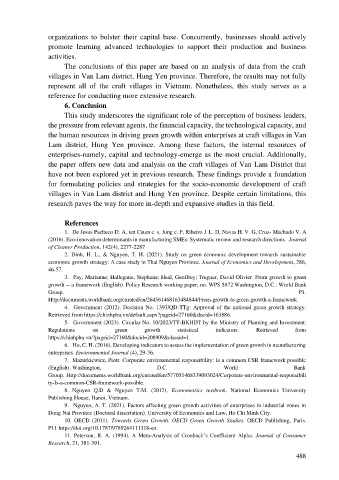Page 496 - Ebook HTKH 2024
P. 496
organizations to bolster their capital base. Concurrently, businesses should actively
promote learning advanced technologies to support their production and business
activities.
The conclusions of this paper are based on an analysis of data from the craft
villages in Van Lam district, Hung Yen province. Therefore, the results may not fully
represent all of the craft villages in Vietnam. Nonetheless, this study serves as a
reference for conducting more extensive research.
6. Conclusion
This study underscores the significant role of the perception of business leaders,
the pressure from relevant agents, the financial capacity, the technological capacity, and
the human resources in driving green growth within enterprises at craft villages in Van
Lam district, Hung Yen province. Among these factors, the internal resources of
enterprises-namely, capital and technology-emerge as the most crucial. Additionally,
the paper offers new data and analysis on the craft villages of Van Lam District that
have not been explored yet in previous research. These findings provide a foundation
for formulating policies and strategies for the socio-economic development of craft
villages in Van Lam district and Hung Yen province. Despite certain limitations, this
research paves the way for more in-depth and expansive studies in this field.
References
1. De Jesus Pacheco D. A, ten Caten c. s, Jung c. F, Ribeiro J. L. D, Navas H. V. G, Cruz- Machado V. A
(2016). Eco-innovation determinants in manufacturing SMEs: Systematic review and research directions. Journal
of Cleaner Production, 142(4), 2277-2287
2. Dinh, H. L., & Nguyen, T. H. (2021). Study on green economic development towards sustainable
economic growth strategy: A case study in Thai Nguyen Province. Journal of Economics and Development, 286,
46-57.
3. Fay, Marianne; Hallegatte, Stephane; Heal, Geoffrey; Treguer, David Olivier. From growth to green
growth -- a framework (English). Policy Research working paper; no. WPS 5872 Washington, D.C.: World Bank
Group. P3.
Http://documents.worldbank.org/curated/en/264561468163484844/From-growth-to-green-growth-a-framework
4. Government (2012). Decision No. 1393/QD-TTg: Approval of the national green growth strategy.
Retrieved from https://chinhphu.vn/default.aspx?pageid=27160&docid=163886.
5. Government (2023). Circular No. 10/2023/TT-BKHDT by the Ministry of Planning and Investment:
Regulations on green growth statistical indicators. Retrieved from
https://chinhphu.vn/?pageid=27160&docid=208909&classid=1.
6. Ho, C. H. (2016). Developing indicators to assess the implementation of green growth in manufacturing
enterprises. Environmental Journal (4), 29-36.
7. Mazurkiewicz, Piotr. Corporate environmental responsibility: Is a common CSR framework possible
(English). Washington, D.C. World Bank
Group. Http://documents.worldbank.org/curated/en/577051468339093024/Corporate-environmental-responsibili
ty-Is-a-common-CSR-framework-possible.
8. Nguyen Q.D & Nguyen T.M. (2012). Econometrics textbook. National Economics University
Publishing House, Hanoi, Vietnam.
9. Nguyen, A. T. (2021). Factors affecting green growth activities of enterprises in industrial zones in
Dong Nai Province (Doctoral dissertation). University of Economics and Law, Ho Chi Minh City.
10. OECD (2011). Towards Green Growth. OECD Green Growth Studies. OECD Publishing, Paris.
P11 https://doi.org/10.1787/9789264111318-en.
11. Peterson, R. A. (1994). A Meta-Analysis of Cronbach’s Coefficient Alpha. Journal of Consumer
Research, 21, 381-391.
488

